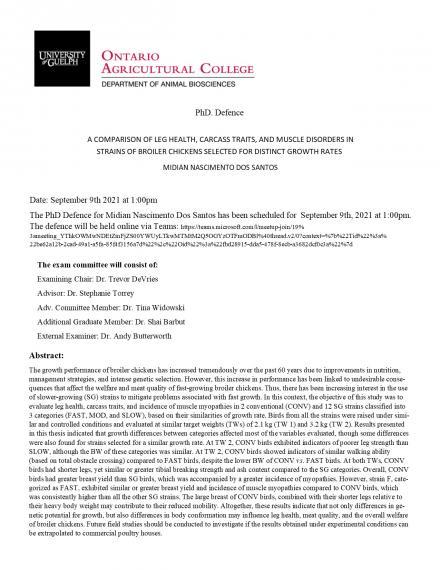Midian Nascimento Dos Santos’ PhD Defence
Date and Time
Location
Teams:https://teams.microsoft.com/l/meetup-join/19%3ameeting_YThkOWMwNDEtZmFjZS00YWUyLTkwMTMtM2Q5OGYzOTFmODBl%40thread.v2/0?context=%7b%22Tid%22%3a%22be62a12b-2cad-49a1-a5fa-85f4f3156a7d%22%2c%22Oid%22%3a%22fbd28915-dda5-478f-8ecb-a3682dcf0c3a%22%7d

Details
The growth performance of broiler chickens has increased tremendously over the past 60 years due to improvements in nutrition, management strategies, and intense genetic selection. However, this increase in performance has been linked to undesirable conse-quences that affect the welfare and meat quality of fast-growing broiler chickens. Thus, there has been increasing interest in the use of slower-growing (SG) strains to mitigate problems associated with fast growth. In this context, the objective of this study was to evaluate leg health, carcass traits, and incidence of muscle myopathies in 2 conventional (CONV) and 12 SG strains classified into 3 categories (FAST, MOD, and SLOW), based on their similarities of growth rate. Birds from all the strains were raised under simi-lar and controlled conditions and evaluated at similar target weights (TWs) of 2.1 kg (TW 1) and 3.2 kg (TW 2). Results presented in this thesis indicated that growth differences between categories affected most of the variables evaluated, though some differences were also found for strains selected for a similar growth rate. At TW 2, CONV birds exhibited indicators of poorer leg strength than SLOW, although the BW of these categories was similar. At TW 2, CONV birds showed indicators of similar walking ability (based on total obstacle crossing) compared to FAST birds, despite the lower BW of CONV vs. FAST birds. At both TWs, CONV birds had shorter legs, yet similar or greater tibial breaking strength and ash content compared to the SG categories. Overall, CONV birds had greater breast yield than SG birds, which was accompanied by a greater incidence of myopathies. However, strain F, cate-gorized as FAST, exhibited similar or greater breast yield and incidence of muscle myopathies compared to CONV birds, which was consistently higher than all the other SG strains. The large breast of CONV birds, combined with their shorter legs relative to their heavy body weight may contribute to their reduced mobility. Altogether, these results indicate that not only differences in ge-netic potential for growth, but also differences in body conformation may influence leg health, meat quality, and the overall welfare of broiler chickens. Future field studies should be conducted to investigate if the results obtained under experimental conditions can be extrapolated to commercial poultry houses.